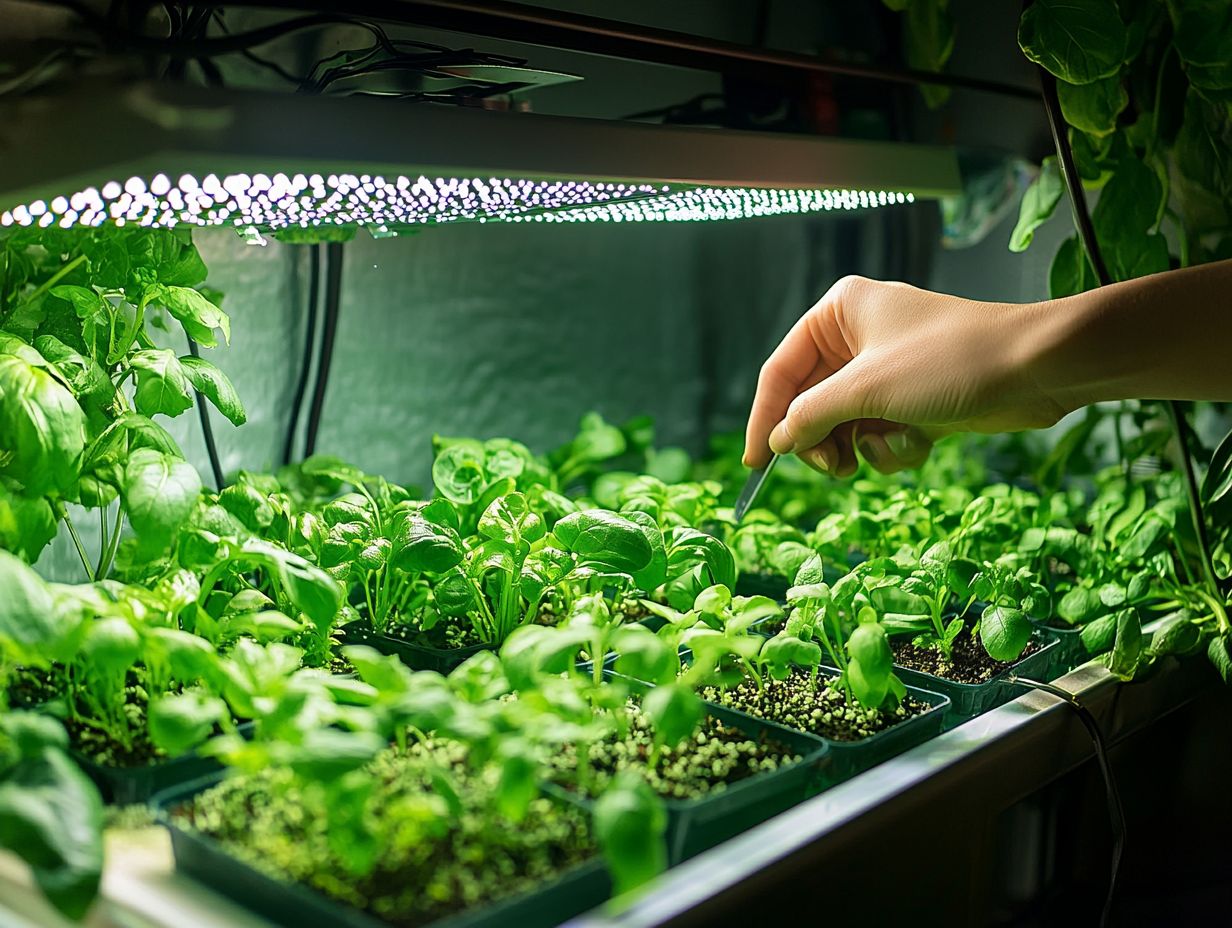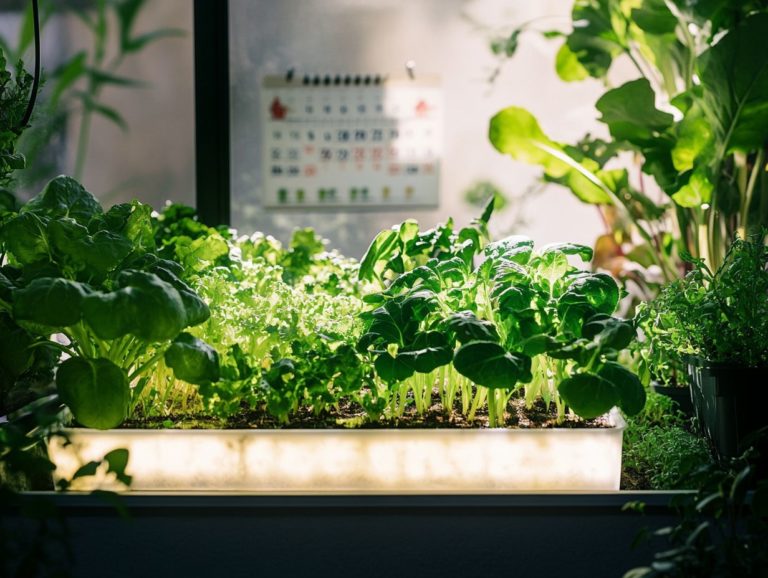How to Use Hydroponics for Food Security?
Hydroponics is revolutionizing how you grow your food, providing innovative solutions that enhance food security in an increasingly unpredictable world.
This article delves into the benefits of hydroponics, highlighting its efficient use of resources and the ability to produce food year-round, along with various systems to meet your specific needs.
You will learn how to select the right crops and receive a comprehensive step-by-step guide for setting up your own system. Plus, we ll cover troubleshooting tips to ensure your garden not only survives but thrives.
Dive in and discover how hydroponics can transform your approach to sustainable agriculture!
Contents
- Key Takeaways:
- What is Hydroponics?
- Benefits of Hydroponics for Food Security
- Types of Hydroponic Systems
- Choosing the Right Crops for Hydroponics
- Setting up a Hydroponic System
- Troubleshooting and Maintenance
- Frequently Asked Questions
- What is hydroponics and how does it contribute to food security?
- What are the benefits of using hydroponics for food security?
- What types of crops can be grown using hydroponics for food security?
- How can hydroponics be used in urban areas for food security?
- Are there any disadvantages to using hydroponics for food security?
- What are some important considerations when using hydroponics for food security?
Key Takeaways:

- Hydroponics offers efficient use of resources, making it an ideal solution for food security.
- With year-round production, hydroponics helps to mitigate the effects of seasonal changes and ensures a consistent food supply.
- When choosing crops for hydroponics, consider factors such as space, nutrient requirements, and growth rate for optimal results.
What is Hydroponics?
Hydroponics is a game-changer that enables you to cultivate plants in water mixed with plant food no soil required. This method is particularly advantageous in urban areas like Boston.
By harnessing advanced agricultural technology, hydroponic systems create ideal conditions for crop growth in a controlled environment. Using various farming methods, like Nutrient Film Technique where a thin film of water with nutrients flows over the roots and Deep Water Culture, which means plants grow in a basin of oxygenated water, allows you to tackle food insecurity effectively. For more information on how to use hydroponics for indoor gardening, you can deliver fresh produce year-round while reducing the environmental footprint typical of conventional farming practices.
Benefits of Hydroponics for Food Security
Hydroponics offers a wealth of advantages for food security, especially in addressing food insecurity in low-income communities. By providing fresh produce that is often scarce in food deserts, this innovative method enhances nutritional quality and promotes healthier diets.
It also supports community development through educational opportunities and local food initiatives. Urban farming powered by hydroponics has the potential to establish sustainable food systems, improving food access and championing food justice initiatives.
Efficient Use of Resources
One of the most significant advantages of hydroponics is its efficient use of resources, especially in terms of water conservation and nutrient delivery systems that minimize waste while maximizing crop yield. This method provides precise control over nutrient solutions, ensuring that your plants receive exactly what they need essential in urban environments where resources can be scarce.
By embracing advanced technology like automated monitoring systems and artificial intelligence, you can optimize growth conditions tailored to the specific needs of each crop. This approach boosts productivity and significantly lessens the environmental impact often linked with traditional farming methods.
The implications for sustainable agriculture are profound, as this innovative technique helps reduce the carbon footprint while enhancing food security. As hydroponics gains traction, you have the opportunity to streamline the food supply chain, delivering fresh produce directly from urban farms to your local community, thus bolstering resilience and health.
Join the hydroponics revolution today and start growing your own food!
Year-Round Production
Hydroponics enables you to produce fresh vegetables by harnessing controlled environments that shield your crops from adverse weather and the impacts of climate change. This capability guarantees a steady food supply and embraces vertical farming techniques that can dramatically boost crop yields per square foot, especially in urban areas.
Adopting these methods can supercharge food security in your community, decreasing reliance on traditional agricultural practices that often struggle against climate variability. Controlled environments optimize water usage and eliminate the need for harmful pesticides, promoting a more sustainable approach to agriculture.
As urban populations continue to swell, vertical farming is an innovative solution to maximize limited space efficiently. It allows fresh produce to be grown closer to consumers, minimizing transportation emissions and ensuring that nutritious food is consistently available throughout the year.
Types of Hydroponic Systems

You ll discover a range of hydroponic systems, each designed to enhance plant growth using specialized methods like the Nutrient Film Technique and Deep Water Culture.
These systems can be integrated into various environments, including hydroponic greenhouses, and are tailored to address different crop needs and environmental conditions. This versatility highlights the remarkable potential of hydroponics technology.
Comparing Different Setups
When evaluating different hydroponic setups, consider factors such as crop yield, operational costs, and food safety to pinpoint the most efficient system for your agricultural goals. Each hydroponic system presents unique advantages that can significantly influence your food production success.
Take, for example, the nutrient film technique (NFT). It’s celebrated for its efficient use of water and nutrients, making it perfect for fast-growing crops, but it has a vulnerability to pump failures. On the other hand, deep water culture (DWC) allows roots to soak directly in nutrient solutions, fostering rapid growth, yet it requires careful monitoring to avoid diseases.
Another option is aeroponic systems, which use misting to improve oxygen delivery to the roots. While they can offer impressive benefits, they often come with higher initial investments. By understanding these specific details about how the system works, you can optimize your crop yield while aligning with sustainable practices, minimizing resource waste and efficiently supplying fresh produce to local communities.
Choosing the Right Crops for Hydroponics
Selecting the right crops for hydroponics is vital for maximizing your yields and producing high-quality produce that aligns with market demand. Evaluate factors such as growth rate, nutrient needs, and disease resistance to choose crops that thrive in a hydroponic setting.
This strategic selection boosts your productivity and enhances food distribution strategies, ensuring food safety.
Factors to Consider
When selecting crops for your hydroponic systems, consider several crucial factors. Think about crop yield potential, the suitability of your nutrient solution, and the optimal growing conditions. Each crop type brings unique challenges and requirements that need addressing for a successful harvest.
To maximize productivity and ensure healthy growth, it s essential to understand each plant’s specific needs from light and temperature to humidity. The pH levels and how well the nutrient solution can conduct electricity, related to nutrient levels, will directly impact nutrient uptake, which can vary dramatically across different crops.
Don t overlook factors like growth cycle duration, disease resistance, and market demand, as these play a pivotal role in making the right selection. By carefully considering these elements, you can create an optimal environment tailored to your chosen crops, leading to better yields and more sustainable practices.
Setting up a Hydroponic System
Setting up a hydroponic system requires meticulous planning and execution. You ll start with installing the hydroponic systems and establishing efficient nutrient delivery mechanisms that help plants grow better.
This process invites community involvement, allowing local stakeholders to actively participate in creating sustainable urban farming initiatives.
Step-by-Step Guide

The step-by-step guide to installing a hydroponic system involves a thoughtful approach. Start by planning your layout and selecting the right hydroponic systems. Prepare a nutrient solution that promotes healthy plant growth. Engaging with community support during setup is vital, as it fosters collaboration and enriches your educational journey.
Begin by assessing your available space and light conditions. Both are crucial for optimizing plant growth. Next, choose a system that aligns with your goals be it nutrient film technique (NFT), where a thin film of nutrients flows over plant roots, deep water culture, where plants sit in nutrient-rich water, or aeroponics. This choice can significantly impact both yield and maintenance efforts.
Preparing the nutrient solution is crucial. Understand what each plant needs for optimal growth. Consult reliable sustainable agriculture resources and experiment with homemade blends to find what works best for you.
Community involvement can be a game-changer, offering invaluable resources ranging from shared experiences to collective purchasing of supplies. This enhances your setup and promotes environmental sustainability by reducing waste and energy consumption. Connecting with local gardening clubs or online forums opens doors to knowledge sharing and support, reinforcing the significance of collaboration in mastering hydroponic practices.
Troubleshooting and Maintenance
Troubleshooting and maintenance are paramount pillars in successful hydroponic farming. They not only help you preempt common challenges but also ensure the safety of your food supply.
By regularly monitoring your hydroponic systems, you can effectively mitigate risks like nutrient imbalances and the threat of foodborne illnesses, thus protecting both your crops and the well-being of consumers.
Common Issues and How to Address Them
Common issues in hydroponic systems often include nutrient solution deficiencies, pest infestations, and fluctuations in plant health. Each can jeopardize food safety. Addressing these problems promptly, through careful monitoring and adjustments to your nutrient solution, is key to ensuring the longevity and productivity of your system.
For instance, when you notice yellowing leaves or stunted growth, it s a clear sign to re-evaluate your nutrient mix. Regularly check the pH and electrical conductivity of your solutions, ensuring they stay within optimal ranges specific to each crop.
Pest infestations can escalate quickly if not managed promptly. Implement integrated pest management techniques, such as introducing beneficial insects or utilizing organic pesticides. Consistently inspecting plant health and environmental conditions enhances resilience, ultimately contributing to improved yields and ensuring that food safety standards are upheld.
Watch this video for tips on hydroponic setup!
Frequently Asked Questions
What is hydroponics and how does it contribute to food security?
Hydroponics is a method of growing plants without soil, using a nutrient-rich water solution instead. It allows for year-round cultivation and high-density production, making it a valuable tool for improving food security.
What are the benefits of using hydroponics for food security?

Hydroponics allows for more efficient use of space and resources, making it possible to grow more food in smaller areas. It also reduces the risk of crop failure due to weather conditions and allows for year-round cultivation, providing a more stable food supply.
What types of crops can be grown using hydroponics for food security?
Leafy greens and herbs, like lettuce, kale, and basil, thrive in hydroponic systems. You can also grow fruiting crops, such as tomatoes and peppers, but root crops and larger plants may struggle in this setup.
How can hydroponics be used in urban areas for food security?
Hydroponics is a game-changer for urban areas with limited farming space. It’s perfect for small spots like balconies and rooftops, delivering fresh, nutritious produce directly to local communities.
Are there any disadvantages to using hydroponics for food security?
The initial setup cost of hydroponic systems can be higher than traditional farming. However, you ll get a great return on your investment with increased yields and less water use over time.
What are some important considerations when using hydroponics for food security?
Monitor nutrient levels, acidity, and water quality for healthy plants. Good lighting and temperature control are crucial. Regular maintenance is key to preventing pests and diseases.






